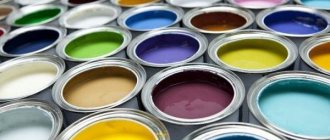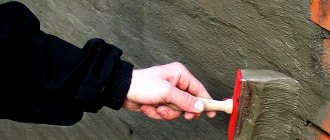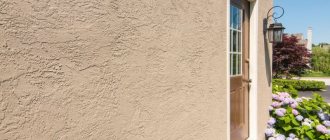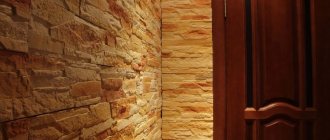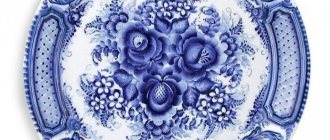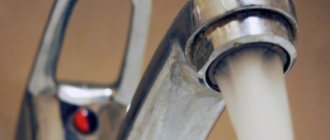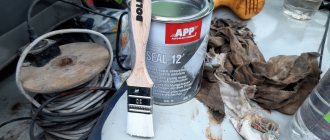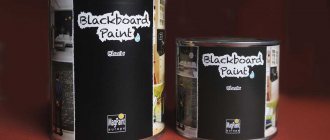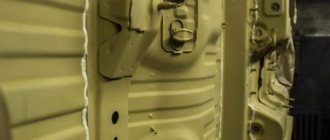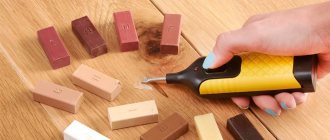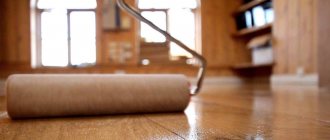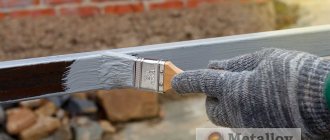External cork covering for house walls. Cork coating for facades
Instructions for applying "ISOCORK"
Surface preparation
- The surface to be treated must be undamaged, perhaps slightly damp, but not wet.
- Do not apply the material to dusty surfaces or surfaces with peeling paint.
- To avoid “variation of colors” it is necessary to apply the first layer, wait for it to dry completely, and then apply the second layer.
- Not to be treated, adjacent surfaces must be protected. The protective material must be removed after application and before drying ISOCORK.
- Cleaning of working tools and dirty surfaces is carried out before ISOCORK dries
- Depending on the absorbent properties of the surface, the ambient temperature at the time of application and air humidity, the material dries from 8 to 48 hours (plaster, brick, concrete - 1 day, on non-porous (iron, glass, plastic, ceramics) - up to 3 days )
Operating procedure
1 Open the bucket and move ALL the material into a large container.
2 Mix the material with a PAD MIXER until a thick viscous homogeneous mass without lumps is obtained. It is better to use a 2-spindle paddle mixer to reduce mixing time.
3 In case of long-term storage of the product, if necessary, add a small amount of water per 12 kg of product from 100g to 250g. It is recommended to add water gradually in small portions, thoroughly mixing the product, achieving a homogeneous mass, the consistency of a “thick viscous mass”. There should be no water deposits on the surface of the product. Excessive amount of water will change the quality of the coating.
4 Apply the finished material using uniform movements, without pauses. It is recommended to use pressure from 2 to 3 atmospheres and holding the gun at a distance of 25 to 80 cm. The material is applied in layers. It is necessary to apply the first uniform layer of the material about 2.5 mm, and leave it to dry for 24 hours (after this time the material dries and approaches its final color, and then it will be easier to notice defects in the application), and then apply a second uniform layer about 1.5 mm. to even out the color and thickness of the material
Excessive operating pressure accompanied by short spacing can cause a large portion of the material (especially cork) to "bounce" and create unsightly depressions in the finished surface with possible porosity that does not provide good protection.
SPRAY LIQUID PLUG
SUBERPLAST
- a liquid mixture of natural cork chips and special polymers, which is applied by air spraying to any type of material and to any surface.
Ease of use, aesthetics, functionality, durability and ease of use - all the qualities necessary for an ideal result are combined in one product.
Application of SUBERPLAST
, allows you to get an amazing decorative textured cork coating, with high functional advantages and characteristics. This coating retains all the qualities of natural cork: environmentally friendly, vapor-permeable, heat and sound insulating, resistant to precipitation and biological decay.
PRACTICALITY
Easy to use allows you to apply SUBERPLAST
without special surface preparation, without expensive equipment and without the involvement of specialists. It is enough to have at your disposal a regular compressor and a textured HOPPER gun.
VERSATILITY
SUBERPLAST coating
suitable for application on any type of material: reinforced concrete, plaster, natural stone, facing brick, silicate blocks, plywood, OSB, timber, asbestos, metal.
THERMAL INSULATION
SUBERPLAS
T is a warm coating (λ=0.038) that will protect your home from cold and heat.
A natural feature of cork, and therefore of the SUBERPLAST coating, is the ability to maintain an internal temperature of no lower than 0 ° C when it is frosty outside and not higher than +20 ° C when it is hot. Thanks to these natural properties of cork, the walls of the house will not freeze in winter and overheat in summer, which will save heat energy. SUBERPLAST
applied to roofing (especially metal) coatings makes it possible for residential attic spaces to maintain a constant temperature of no higher than +20 °C in summer.
SOUND INSULATION
Used both indoors and outdoors, SUBERPLAST
is able to reduce noise where there are thin plasterboard partitions, in interfloor ceilings, in technical rooms where moving mechanisms and equipment are located.
In addition, the use of SUBERPLAST
on a metal roof softens the annoying noise of rain.
WATER PROTECTION
The water-repellent properties of cork are well known, and its application to facades provides reliable protection from rainwater, increasing the service life of the facades themselves.
VAPTOR PERMEABILITY
The internal microclimate of our homes depends on the temperature and humidity conditions of the room. SUBERPLAST
, performing the function of a membrane (m=31), allows moisture accumulated in the walls of houses to evaporate, thereby preventing the appearance of mold and mildew on the walls.
DECORATIVENESS
SUBERPLAST
Supplied in a basic natural cork colour.
The product is easily painted using pigment paste, according to the SUBERPLAST
(46 options) and the RAL scale.
ECONOMICAL
A small consumption of material (1-1.2 kg/m2) allows you to obtain a decorative
SUBERPLAST
easily painted using SUBERPLAST COLOR pigment paste, according to the SUBERPLAST primary color table (46 options) and the RAL scale.
Pigmenting paste for SUBERPLAST
easy to apply: supplied ready to use according to the chosen color, in doses calculated for one bucket of
SUBERPLAST
.
Just add the paste to the SUBERPLAST
and mix for several minutes with a mixer.
Cost of application work taking into account the cost of the material:
2,100 rub./sq.m.
| A zurro | Blue | ||
| Brick red | Dark brown | Dark gray | Dark green |
| deep blue | Deep green | Gray light | green bush |
| Orange I-005 | |||
| Petrol green 21 | Petrol green 24 | Petrol green 25 | Petrol green |
| Real pink | Red flag | Roman pink | Rust red |
| Yellow I-001 |
Facade cladding materials are used at the final stage of building construction to give them a stylish and neat appearance. Each of the cladding options has its own advantages and disadvantages, but it is liquid cork for the facade
Today it is the leader in Moscow and the Moscow region in terms of positive reviews from both builders and customers.
sprayed cork for cladding the interior or exterior of the house.
. This is a universal material that has a lot of advantages: protection from ice and rot, sound and noise absorption, fire resistance, insulation, as well as an aesthetic appearance.
Made from tree bark, it is a natural and ecological material that does not cause allergies and is absolutely safe for humans. By the way, Nanocork on walls and facades is not prone to dust accumulation, which means that allergy sufferers have nothing to fear in this case either!
The main advantages of liquid cork for Nanocork facades
Let's look at why it is better to give preference and buy liquid stopper for the facade
in Moscow, Khimki today. Why, among the mass of modern building materials, sprayed cork coating deserves special attention? Let's figure it out in order.
EASY TO APPLY
Application of Nanocork cork coating by air spraying does not require complex equipment - just a compressor and a gun. At first glance, this can be dealt with without much difficulty. But we want to warn you that without experience and knowledge of technology, you risk simply transferring materials and not getting high-quality cladding. And it’s expensive to purchase equipment for one time. It is better to immediately contact specialists and get liquid stopper for the facade at the best price.
UNIVERSAL COATING
Cork coating is distinguished by its versatility and high coefficient of adhesion; it can be applied to glass, natural stone, brick, wood, SIP panels, plaster, etc. Buy liquid cork for the facade
Can be used on any surface!
FAST APPLICATION
Liquid cork for the facade is applied in 2 layers. The first word, as a rule, serves as adhesion to the surface, and the second - directly as a facing. The approximate consumption per m2 is 1.8 - 2 kg.
THERMAL INSULATION and WATERPROOFING
Sprayed cork covering Nanocork will keep you warm in winter and cool in summer. Due to the natural property of cork, like a thermos, to maintain the internal temperature, Nanocork lining will allow you to enjoy comfort at any time of the year! Just like houses made from SIP panels
, and cork covering will allow you to significantly save on heating in winter. Also, the liquid cork coating reliably protects the surface from exposure to water.
AESTHETICS
First of all, cladding serves to add beauty to the appearance of facades or walls. Nanocork copes with this 100%. You can choose any color you like from the palette, which will best suit both the design style and your preferences. Plaster, water-based paint, etc. fit well on cork. If in the future you want to change the coating, then cork on the surface of the walls will not complicate the process.
SOUNDPROOFING
By its nature, the bark of the cork tree has excellent noise-absorbing properties, which allows the Nanocork liquid cork
create good sound insulation. This makes this cladding in demand both in private homes and in public institutions. Among our customers there are many cafe and restaurant owners.
Where is Nanocork Liquid Stopper Used?
Liquid cork for facades in Moscow is used for both external and internal decoration. Thanks to its excellent heat and sound insulation properties, Nanocork coating has become an indispensable modern finishing material for residential buildings, industrial buildings, and public places. This includes insulation, protection from moisture, and decorative finishing. And the low price of liquid cork for facades
only adds to her popularity. You can see the “Before” and “After” option for finishing house facades with Nanocork coating in the photo.
A large palette of colors and the original texture of cork cover allows it to be used as an original decor for walls in the interior.
We are often approached by clients who want to update the appearance of their home or re-cladding a newly built one, within a small budget. In this case, we recommend liquid cork for facades Nanocork price
which suits any budget. The sprayed coating will not only give an aesthetic appearance to the building, but will also reliably protect it from destruction from external factors.
This material is quite simple to use. Its surface is antistatic and easy to clean. Greasey stains can be easily removed with a solvent. Mechanical damage can be repaired.
Do you have any questions about Nanocork Liquid Stopper? Contact our manager
8-499-409-58-54
8-915-795-52-68 (Viber, WhatsApp available)
Thermal insulation of walls is an important step towards solving the problem of energy efficiency and resource conservation. Walls take second place after windows in terms of heat loss.
There are two options for their insulation: outside and inside. Installation of a heat-insulating layer from the inside is carried out in the most extreme cases, when no other option is possible.
In most cases, preference is given to thermal insulation of the walls outside the building. For this purpose, solid and liquid based materials are used. Solid sheet material has been used for a long time, its performance has been tested by time.
Construction technologies do not stand still. Increasingly, a liquid façade is being used to construct a thermal insulation layer. In many performance indicators it is superior to classic solid insulation.
Insulation of facades with liquid insulation is carried out from the outside of the building. Depending on the physical, chemical and operational characteristics, there are several types of liquid thermal insulation:
- Penoizol;
- Teplokor;
- Armor;
- Corundum;
- Liquid plug;
- Liquid travertine.
Penoizol
Liquid material that fills the cavity between the wall and the curtain wall. It is manufactured directly on the construction site from several components that are mixed and then applied with a compressor with a spray nozzle.
Penoizol belongs to the class of foam plastics. Unlike solid analogues, it fills all cracks, creating a monolithic barrier from the external environment.
Insulation of facades with liquid foam insulation protects the interior not only from heat loss, but also from noise. Its porous structure contributes to good sound insulation.
If you protect it from moisture, its service life will be 50-75 years. Penoizol practically does not burn and complies with modern fire safety standards. After drying, it does not release compounds harmful to the human body.
The drying time is 5-7 hours, and the initial setting time is 15-20 minutes. This allows you to process up to 50 m2 of wall per day.
Penoizol absorbs moisture and steam. Therefore, walls below ground level can only be treated with good waterproofing. Penoizol has a high shrinkage rate and emits a harmless but unpleasant odor.
Penoizol is often applied to a mesh of polymer fibers. This way you can apply a thick layer without worrying about integrity.
Teplokor
Liquid thermal insulation of facades Teplokor belongs to the class of thermal paints. Thermal paint is a material for creating a thin energy-saving barrier between the wall and the environment.
The paint contains microscopic balls that prevent the transfer of heat from the inside of the wall to the outside. After complete drying, it forms a matte barrier, the so-called “thermal mirror”.
Teplokor is a popular type of liquid finishing. It is used to treat walls inside and outside the building. The composition includes acrylic-based polymers, microscopic glass-ceramic hollow balls, and additives. To obtain a wide palette of colors, pigments of artificial origin are used.
Teplokor effectively protects against heat loss. It is easy to apply to almost any surface. The paint can be used to treat wooden, brick, and concrete walls of public, industrial, residential buildings, as well as cottages and country houses.
Teplokor protects walls from the aggressive action of precipitation. Fungus and mold do not develop on the surface treated with it. Thermal insulation paint complies with modern fire safety standards.
The wall surface does not require special preparation. It is enough to clean it of dirt and old paint, and then treat it with acrylic-based primer. Teplokor does not contain solvents, so it does not emit an unpleasant odor.
Armor
Liquid thermal insulation for facades Bronya is widely used for processing brick, concrete buildings, as well as metal structures. The structure of the material is similar to thick white sour cream.
The thickness of the protective layer is 1-3 mm. Such impressive performance is achieved due to a unique and thoughtful composition. The basis of liquid thermal insulation Bronya is an acrylic-based binder. Fine ceramic granules of a closed structure are responsible for thermal conductivity.
To achieve layability and speed up drying, the composition includes catalysts and fixatives. To prevent the development of corrosion and fungus, the composition includes special substances.
Liquid insulation can be used to cover the external walls of a panel house
The armor provides high-quality protection for house facades, as well as pipelines and other large-sized metal vessels from moisture and temperature changes. The protection does not lose its properties in the temperature range from -60 to +270 degrees.
The layer thickness does not exceed 6 mm, which has a positive effect on the cost per square meter. With a layer thickness of 5 mm, the consumption per square meter is 5-6 liters.
High adhesion reliably secures liquid thermal insulation to almost any surface. Minimum service life is 15 years.
There are several types of Bronya liquid insulation:
- Classic - can be applied to any surface. The only limitation is that it cannot be used in winter.
- Anticorrosive – used for treating rough metal surfaces. Can be used without preliminary rust removal.
- Winter – used for processing at temperatures up to – 35 degrees Celsius.
- Facade - used to insulate the external surfaces of walls. The thickness of each layer is 1 mm.
Liquid thermal insulation of the façade is applied to a degreased surface using a brush or spatula. The thickness of each layer is 1 mm.
Corundum
Liquid thermal insulation for facades Corundum is a composition of polymers and latex. The polymer-latex binder is filled with closed-type ceramic balls up to 0.5 mm in size.
Thermal insulation Corundum is similar in appearance and consistency to ordinary oil paint. It is used to protect brick, concrete and stone surfaces, as well as for processing critical metal structures such as pipelines and tanks.
Corundum is a light and elastic material. It creates reliable adhesion to the surface being treated. The thermal conductivity coefficient of 0.0012 W/(m*C) is significantly lower than that of classic insulation materials such as foam plastic or mineral wool. Corundum is not destroyed by moisture, but allows the walls to “breathe”.
In terms of fire resistance, Corundum belongs to class G1 and does not support combustion. When the surface is heated to +800 degrees Celsius, it begins to decompose into simple components.
The insulation does not collapse in the temperature range -60 to +260 degrees, and does not crack under ultraviolet rays. Fungus and mold do not develop on a wall treated with Corundum, and it is not damaged by rodents. It releases substances harmful to the human body.
Liquid thermal insulation Korund has an average service life of 10 years, which, combined with the high price, imposes certain restrictions on use.
Liquid stopper for facade
Finishing the facade with liquid cork is a step towards an eco-friendly home made from natural materials. Mainly used for insulation and finishing of facades of country houses.
Liquid cork is an insulation based on oak bark, water and additives to increase ductility and adhesion.
Cork has good thermal insulation properties. It dampens most sound waves, providing acceptable sound insulation.
Mold and fungus do not develop on a façade treated with liquid cork and are not destroyed by insects. It does not crack under the rays of the sun. At a low cost per square meter, you get a beautiful surface that can be painted.
Liquid cork coating for facades adheres reliably to wood, stone and glass surfaces.
All insulation work can be done with your own hands. No surface preparation is required. The liquid plug is applied using a compressor with a spray gun.
It is better to lay the mixture in several layers. Liquid cork is applied to the wall at an air temperature of at least +5 degrees.
Liquid travertine on the facade
Travertine or liquid stone for facades is a combination of protective and decorative material. It can be applied both to durable, stable stone or concrete surfaces, and to unstable ones sheathed in plastic or metal.
Travertine does not allow moisture to pass through. Allows walls to “breathe”. The facade treated with liquid travertine is reliably protected from abrasion and mechanical damage.
Travertine is not destroyed by precipitation and ultraviolet rays. The guaranteed service life is 30 years. Using travertine you can create a textured pattern.
The finishing of the facade with liquid travertine is carried out at an air temperature of +2-+30 degrees.
Liquid glass for building facades
Liquid glass is used for waterproofing, as well as thermal insulation of facades, plinths, and internal walls. Liquid glass or silicate glue is rarely used in liquid form. As a rule, it is mixed with cement and the surface is treated. Liquid glass is often included in facade paints.
Silicate glue is an environmentally friendly and safe material. It complies with modern fire safety standards. It is mainly used for waterproofing, but liquid glass has also found application as a heat-insulating material.
There are two types of glass:
- Sodium - consists of sodium silicate.
- Potassium - consists of potassium nitrate.
Both substances have approximately the same properties and are used both in construction and in the chemical industry.
Liquid wallpaper is a textured finishing material based on cellulose fibers and an organic binder. Most often used for finishing interior spaces or facades of private houses under the roof. For example, covered verandas or gazebos that are adjacent to the house.
Liquid wallpaper can be applied to any surface: stone, concrete, wood, finished with plasterboard. They have a high rate of vapor permeability, the surface of the wall is “breathable”. Dust does not stick to warm wallpaper and it does not become electrified.
The wall, treated with liquid wallpaper, does not lose heat and does not let in extraneous sounds. They do not smell and do not emit harmful substances.
Liquid wallpaper is applied with a roller onto a surface that has been previously cleaned and impregnated with acrylic primer. First of all, the base coat is applied. After 5-6 hours, after pouring the wall, you can apply a textured pattern with a roller.
The term liquid facade refers to a variety of materials and technologies that make it possible to create a strong, reliable, durable coating with high thermal insulation properties. You can do the work yourself or use the help of professionals.
The modern construction market offers many options for materials for finishing facades, but one of the most popular at the moment is a special facade cork. This material has excellent quality characteristics. Excellent sound and heat insulation qualities. To achieve maximum natural wall structure, cork material is used for finishing cottages or luxury country houses.
What is a traffic jam? This is, first of all, a natural, environmentally friendly and healthy material, which is made from Mediterranean oak bark, which is previously crushed and pressed. The structure of the material is very similar to a honeycomb. Cork for facades has high performance characteristics, this is justified by the fact that the material contains a solution that is not subject to dissolution in alcohol or water, namely cell sap.
Applied liquid cork on the facade of a house
This material has a beneficial effect on the facade of any building; it becomes resistant to high humidity, corrosion and collects much less dust and dirt. Due to its natural structure, the material does not emit substances harmful to the human body, has a large number of useful characteristics and does not allow current to pass through.
Selecting an insulation system and preparing the base
The review of technology should begin with the fact that cork coverings can be used both with and without external insulation. That is, a house made of sandwich panels is quite suitable for such finishing, but there are nuances. One of them is the requirement to fill the seams with a special sealant and properly strengthen them. Otherwise, the cork fully meets the requirements of moving bases. It can be used to process even established log buildings, resulting in a very interesting effect of a monochrome “coat” that exactly follows the shape of the logs.
With insulation, the situation changes. On the one hand, the insulation acts as a damper, absorbing most of the vibrations of the load-bearing layer. The question of impact resistance remains: although cork is a fairly elastic material, the presence of a base layer under it is strictly necessary. However, the base layer itself can be made directly with cork spraying, which is not painted in order to save money. Thus, the total thickness of the coating can exceed 10–15 mm, while maintaining high resistance to impact loads.
Reinforcement of the base should be carried out if the insulation is mineral wool with a density below 150 kg/m3, which does not have a rigid outer layer. Polystyrene boards and similar materials are simply sealed at the joints with acrylic sealant. In this case, incompressible materials must necessarily have adhesive and mechanical attachment to the base. The metal fasteners present do not need to be further protected if the coating contains corrosion inhibitors, such as zinc phosphate.
Wooden bases also do not require additional protection. Due to the hydrophobization of the surface, the wood does not get wet, therefore, a breeding ground for harmful organic matter does not form. Insect pests also do not settle in cork-covered wooden products due to the presence of a hard crust bound with polymer glue.
Why is liquid façade cork needed and its advantages?
Liquid facade cork is a mixture of fine cork crumbs, which are mixed together with a binder and form a single mass. This material is used in various fields of construction, as well as for various types of repairs. It is great for use as a sealant or insulation, an excellent option as a decorative coating or to improve the quality of sound insulation. This is a universal material that is superior in quality and characteristics to many other materials on the construction market.
Liquid facade cork significantly prevails over other finishing materials for the following reasons:
- Liquid facade cork is a completely environmentally friendly and natural material.
- It has high strength and is impervious to any mechanical stress. It has high thermal insulation characteristics.
- It has good adhesion to absolutely any building materials.
- Resistant to temperature changes, performs well in any weather.
How to properly prepare the base for finishing a façade with cork
If you have chosen cork material as the finishing material for your facade, then first you should decide on the type of coating you need. If you choose the right coating, its service life will be much longer and the cost can also be selected according to your needs. Liquid cork is primarily a finishing material, insulation and cladding; it will create the appearance of your home, something that will catch the eye of others. Therefore, it is very important to choose the right material.
Before the application process, it is not necessary to level the entire facade to an ideal state, removing all flaws and irregularities; this coating is perfectly fixed on any surface. The service life of such material, if properly selected and applied, can be more than 30 years. It is fashionable to carry out the entire application procedure with your own hands, without the help of professionals, and it takes a minimum of time.
Everything is pretty quick, you need to apply several layers no more than 3 mm thick. If you do everything correctly, you can immediately process more than 100 square meters at a time. It is worth considering that during the procedure the temperature should not be lower than 5 degrees. Therefore, it is better to carry out the procedure in the warm season.
It must be applied using special spray equipment under compressed air pressure. Thanks to this equipment, maximum thermal insulation of the entire building is achieved and cold bridges are eliminated, plus the treatment process is much faster than applying it with a spatula.
Working with liquid stopper is quite easy; the whole procedure is very simple and does not require the intervention of a specialist. It is enough just to have all the necessary tools for the job.
Step by step application process
Step by step application process:
- Due to its structure and elasticity of the coating, preliminary leveling and preparation of the facade for application is not required. Leveling is only necessary if the walls are in a very poor condition, and even in this case, a rough version of the repair will be sufficient.
- If you follow all the rules for finishing with this building material, you can extend the service life of the coating up to 30 years.
- Equipment for installing cork coating is connected to a compressor and applied using a gun. The compressor supplies compressed air, and the mixture is sprayed over the surface of the facade and external walls.
- Spraying should not be carried out in winter. The air temperature during operation should not fall below +5 degrees. That is why it is better to carry out cladding in the warm season.
- It is recommended to apply spraying in several layers at once. By applying one layer, the problem with the cladding cannot be solved.
- As professionals advise, each layer should be applied no more than 4 millimeters thick.
- If done correctly, you can process 100 square meters of working surface in one go.
- When you have applied the first layer, do not immediately start applying the next one, wait until it adheres well to the base, and then start applying the liquid stopper. During the process, the gun must be kept at a distance of about 40-65 centimeters from the walls. Make the movements in the same way, without stopping and without long pauses.
- How many layers you need depends on your goals. If you are unsure about how many layers your home will need, it is best to consult with a professional. After applying the first layer, wait until it dries, after which the difference in shades will show you where you applied more material and where less, and will give you the opportunity to correct flaws.
- The second layer is applied in a thickness of no more than 2.5-3 mm. It is final and should be applied 6 hours after the initial treatment of your facade with liquid stopper.
Plaster LIQUID CORK
Home \ Plaster LIQUID CORK
Liquid cork coating for plastering and finishing work is a unique material that will solve many problems in the construction industry.
The warranty period for plastering work with liquid cork is 20 years!
Basic
properties:
- elastic;
- fire protection;
- soundproofing;
- vibration isolation;
- biosecurity;
- waterproofing;
- thermal insulation;
- vapor barrier;
- not afraid of rot and mold.
Min. batch 2 buckets 24 kg.
Cork coating has a fire safety class of G1, which classifies the material as low-flammable and makes it possible for its widespread use in civil engineering. Liquid cork coating is used for internal and external seamless insulation and insulation of construction projects: residential, public, industrial, trade and warehouse buildings and structures, as well as foundations, basements, wall fences, underground parking lots
Areas of use:
- Heat saving: indoors, including attics and basements;
- preventing the formation of condensation in interior spaces; protection of building structures in rooms with a microclimate;
- creation of a heat and sound insulating substrate between the concrete base of the floor and the floor covering;
- anti-corrosion coating of metal surfaces;
- anti-corrosion treatment of petroleum product storage tanks;
- softening vibrations on internal structures, bulkheads, partitions;
- sound insulation of buildings and structures;
- creating finishing decorative antistatic coatings indoors; decorative coating in design solutions;
- eliminating local freezing of external walls;
- façade repairs;
- protection of facades from salt deposits;
- fire protection of all types of structures and surfaces;
- adding aesthetics to dilapidated and unattractive facades;
- elimination of microcracks (for example, in garages under a residential cottage).
consumption and conditions of use.
For 1 sq.m. in two layers will be 2 kg (with a layer thickness of 4 mm) .
Operating temperature -40˚С - +80˚С Complete hardening of the coating in 24 hours at a temperature of 20˚C. The flammability group of the material is G1 (self-burning duration is 0 seconds). Operating temperature -60˚С – +160˚С. Complete drying of the coating within 24 - 48 hours at a temperature of 20˚C. The cork covering is light - 1 m³ weighs only 50-120 kg, depending on the thickness of the layer being laid, is resistant to compression and does not shrink.
| P/P | Name of material | Price per kg/rub | Price per bucket, 12 kg/rub. |
| 1 | Universal | 380 | 4560 |
| 2 | Facade | 400 | 4800 |
| 3 | Refractory | 410 | 4920 |
*Additionally, for each kg of material there is 7-8 rubles of delivery (Blagoveshchensk).
The product is supplied in plastic buckets weighing 12 kg/V=22 liters. To apply a liquid cork coating, you will need a spatula or a gun for applying textured materials (for example, Cartouche, Hopper), powered by a compressor with a pressure of 2.5-3 atm (household or industrial). The liquid cork coating can be tinted in any color. Delivery, discounts, professional advice.
Plaster, insulation, waterproofing, vapor barrier, sound insulation, liquid cork, do-it-yourself repair, leaking, well, swimming pool, garage, foundation, water stop, sealing seams, sealing, delivery, building materials, Moscow. Moscow region, region, finishing materials, cork for walls, coating, finishing materials wholesale, finishing materials, plaster, decorative plaster, wall plaster, plaster price, plaster + do it yourself, gypsum plaster, under plaster, applying plaster, textured plaster, decorative plaster photo, buy plaster, buy plaster, decorative plaster + with your own hands, bark beetle plaster, wall plaster + with your own hands, plaster + with your own hands video, cement plaster, rotband plaster, wall plaster video, applying decorative plaster, ceiling plaster, silk plaster, wall plaster price, facade plaster. finishing with plaster, plastering of houses, plaster consumption, decorative plaster price
